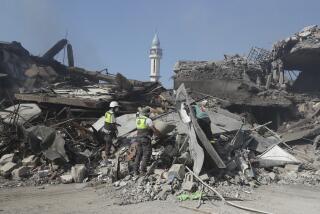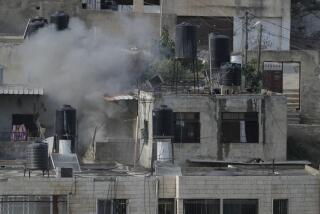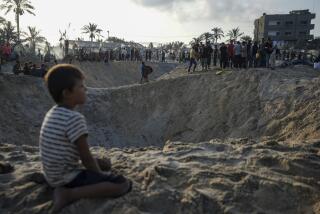Massacre at Jenin Doubted
JENIN, West Bank — No matter how few bodies have been found, people in Jenin remain convinced that Israeli soldiers committed a massacre here. But there is a growing consensus among human rights groups, international aid workers and even some Palestinians that no massacre took place.
Palestinians have maintained since Israel’s attack on Jenin and the West Bank town’s refugee camp last month that between 300 and 500 Palestinians were killed.
“Everybody saw what happened,” said Abdul Karim Saadi, 26, who said he was wounded by Israeli gunfire while sleeping in his bed. He lifted his shirt to show a long raw scar on his stomach and a bandage on his shoulder.
However, Israeli government officials have said that 54 Palestinians died, all but seven of them members of militant groups that had turned the camp into a terrorist haven. Twenty-three Israeli soldiers also were killed.
Human Rights Watch today became the latest group to weigh in. It released a report that found no evidence of a massacre, although it uncovered “very serious violations of the laws of war,” according to senior researcher Peter Bouckaert.
Through interviews, the human rights group documented 52 deaths in the camp, of which 22 were civilians. Of those, researchers said, 10 appear to be war crimes. The rest are in need of further investigation but could be attributable to human error or be less serious human rights violations, it said.
Human Rights Watch also raised concerns about disproportionate use of force, the use of civilians as human shields, and the Israeli military’s denial of access to medical and aid groups during and after the attack.
The Israeli military denied those allegations. It said Palestinians, not the Israeli army, had used human shields. And it said it prevented ambulance access only when the situation was too dangerous.
The army also said the low number of casualties known so far was evidence of Israel’s caution during the operation.
The Israeli army “anti-terror operation was planned and conducted strictly against terrorists, not civilians,” read a statement released by the military late Thursday.
The Times and other media also have conducted investigations that failed to turn up evidence of mass executions, though the reports raised questions about individual incidents that could be human rights violations.
Amnesty International, another rights group, has already dismissed the massacre allegations, though its inquiry also found examples of human rights violations.
Worries About Diverted Attention
Indeed, some researchers have begun to worry that the focus on whether a massacre took place has diverted attention from allegations that other serious abuses occurred during the operation.
“No one is denying that there were militant groups operating in the camp. But that does not excuse the Israeli army from protecting the civilian population,” Bouckaert said.
Even some Palestinian officials interviewed Thursday acknowledged that the 300 to 500 figure was probably not true.
Ahmed Kassan, the assistant director of the refugee camp, said 51 corpses had been found and estimated that perhaps 30 more remain buried in the rubble. A Palestinian medical worker, who declined to give his name, confirmed Kassan’s estimate.
Kassan said he was still waiting to get a final list from the International Committee of the Red Cross of the people still missing. But he said he doubted that the final figure would exceed 80 dead.
He remained adamant, though, that the Israeli army bore a heavy responsibility.
“Look at this camp,” he said, pointing to the stacks of rubble that were once homes to hundreds of refugee families. “Don’t you think that’s a massacre?”
This was the sort of question the United Nations was hoping to help answer when it proposed opening an inquiry into the Jenin attack, already famous among Palestinians as a symbol of resistance.
But the Israeli government refused to cooperate with the team, expressing fears that the report would be biased against the Jewish state.
Israeli officials pointed out that none of the three leaders of the mission had experience in urban warfare. They also worried that their soldiers might be tried for war crimes. Israel and the United Nations were unable to reach a compromise.
Bouckaert said a U.N. report would have helped settle the debate, at least in some circles.
“It’s clear there are very divergent views about what happened in Jenin,” Bouckaert said. “It would have been very important for the U.N. team to get here and establish a credible, impartial picture.”
Small parts of that picture have filled in during the last few weeks, as Israeli forces pulled out of most West Bank towns and aid officials began the slow, hard work of assessing the damage.
The U.N., which operates refugee programs in the camp, now estimates that about 800 of the 2,450 dwellings were destroyed during the Israeli operation and 300 more rendered unlivable.
The World Bank believes that the total cost of damage to buildings and infrastructure could reach as high as $100 million in the camp and the sprawling city that surrounds it.
Israeli tanks and bulldozers leveled more than 100 buildings during the operation, turning the heart of the camp into a gray moonscape of dust, reinforced steel bars and shattered homes.
Tanks and armored personnel carriers destroyed streets, knocked down lampposts and utility poles and ruined underground water and sewage pipes, according to city officials.
Blackouts and phone outages remain common. Pools of water and sewage can be seen bubbling up throughout the camp.
“All of the buildings in the camp had some damage,” said Hisham Labadi, a local official with the World Bank.
“There are no buildings that don’t have at least some bullet holes.”
More to Read
Sign up for Essential California
The most important California stories and recommendations in your inbox every morning.
You may occasionally receive promotional content from the Los Angeles Times.










